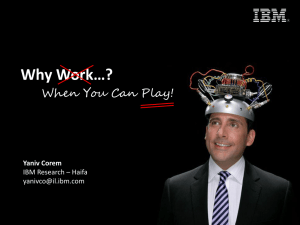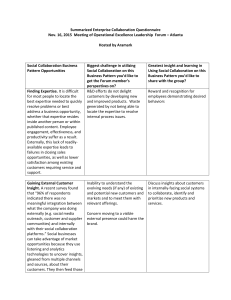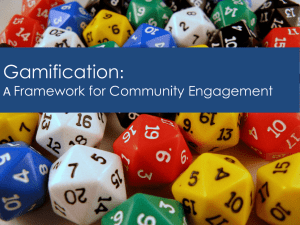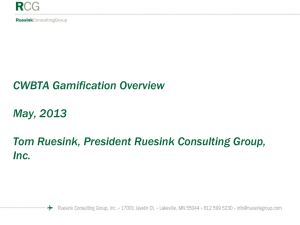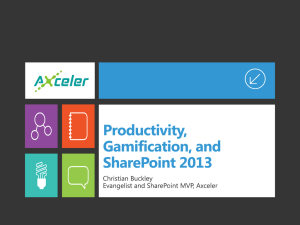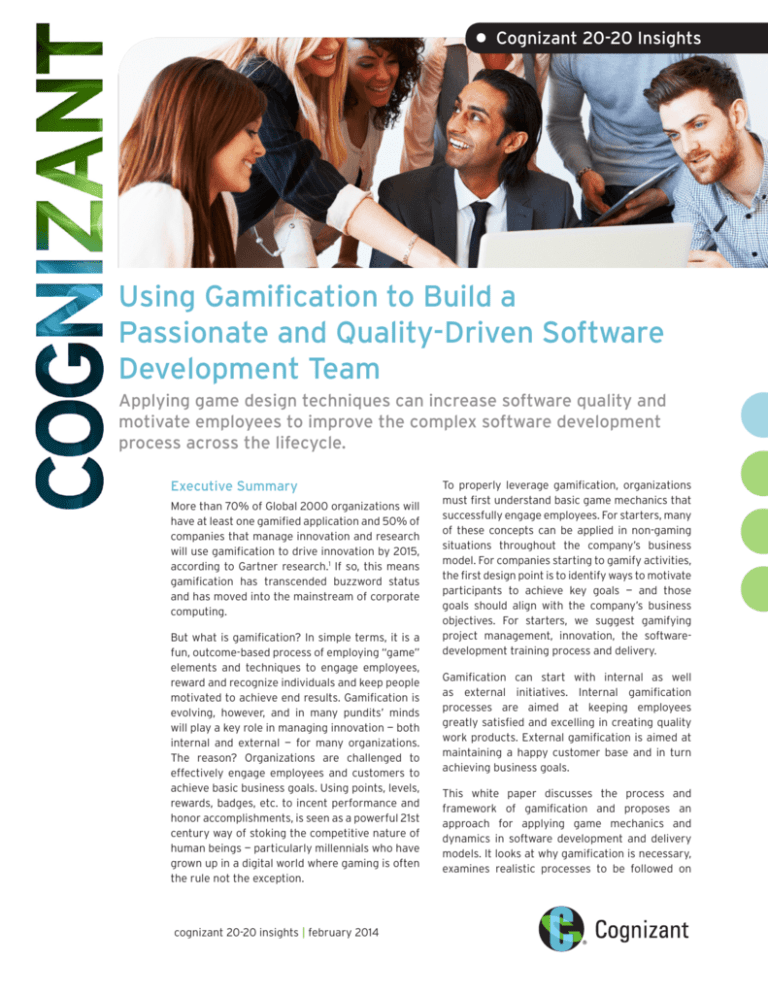
• Cognizant 20-20 Insights
Using Gamification to Build a
Passionate and Quality-Driven Software
Development Team
Applying game design techniques can increase software quality and
motivate employees to improve the complex software development
process across the lifecycle.
Executive Summary
More than 70% of Global 2000 organizations will
have at least one gamified application and 50% of
companies that manage innovation and research
will use gamification to drive innovation by 2015,
according to Gartner research.1 If so, this means
gamification has transcended buzzword status
and has moved into the mainstream of corporate
computing.
But what is gamification? In simple terms, it is a
fun, outcome-based process of employing “game”
elements and techniques to engage employees,
reward and recognize individuals and keep people
motivated to achieve end results. Gamification is
evolving, however, and in many pundits’ minds
will play a key role in managing innovation — both
internal and external — for many organizations.
The reason? Organizations are challenged to
effectively engage employees and customers to
achieve basic business goals. Using points, levels,
rewards, badges, etc. to incent performance and
honor accomplishments, is seen as a powerful 21st
century way of stoking the competitive nature of
human beings — particularly millennials who have
grown up in a digital world where gaming is often
the rule not the exception.
cognizant 20-20 insights | february 2014
To properly leverage gamification, organizations
must first understand basic game mechanics that
successfully engage employees. For starters, many
of these concepts can be applied in non-gaming
situations throughout the company’s business
model. For companies starting to gamify activities,
the first design point is to identify ways to motivate
participants to achieve key goals — and those
goals should align with the company’s business
objectives. For starters, we suggest gamifying
project management, innovation, the softwaredevelopment training process and delivery.
Gamification can start with internal as well
as external initiatives. Internal gamification
processes are aimed at keeping employees
greatly satisfied and excelling in creating quality
work products. External gamification is aimed at
maintaining a happy customer base and in turn
achieving business goals.
This white paper discusses the process and
framework of gamification and proposes an
approach for applying game mechanics and
dynamics in software development and delivery
models. It looks at why gamification is necessary,
examines realistic processes to be followed on
the ground and identifies the key benefits to be
reaped, supported by case studies from projects
we have implemented. We will also explain
how game design techniques can be used in
non-gaming environments that not only engage
and motivate employees, but also improve
customer satisfaction and engagement, gleaned
from our client interactions.
Why Gamification?
Most organizations are challenged to understand
business initiatives or employee behavior
changes that can affect the achievement of
long- and/or short-term goals. Moreover, gaming
techniques, although in vogue as a result of the
digital revolution, are not really new. In fact, many
organizations already have reward systems to
recognize their employees’ work (i.e., “Employee
of the Month/Year”) and thereby increase
employee engagement and motivation levels.
Once the basic definitions are understood, organization need to ask the following questions:
• What are the problem areas?
• Why should we invest in gamification?
• How can business use gamification to engage,
foster collaboration among and motivate
employees?
In the traditional feedback cycle, employees often
wait a year for their performance to be recognized
by management. By changing existing protocols
and processes, organizations can enable fast
and meaningful feedback, accelerating employee
growth and learning. This is important for organizations seeking to build or extend momentum.
Sadly, in many businesses short-term goals are
unclear, particularly as the business environment
evolves, making change inevitable. Moreover,
rules often lack transparency; rewards and recognition are rarely given to participants who excel
across functional areas throughout the year.
Long-term goals are often more focused, but
companies need to work to establish small wins,
intermediate milestones and a drive to master
new skills to keep employees motivated and
contributing business value. To extend competitive advantage, they need systems to enable
employees to earn rewards and respect within
their peer groups, as well as to validate their skills
and the abilities of others. The key is to create
competition in a scalable, automated way that
can be used to drive repeatable results. Driving
competition, collaboration, networking and
knowledge-sharing among employees is critical
to achieving long-term organizational goals.
Gamification: What Is It?
gamification = gam(e) + -ification
• applying game-design thinking to non-game applications to make
them more fun and engaging
Games
(Serious)
Games
Gamification
Whole
Partial
Playful
Designing
Toys
Play
Figure 1
cognizant 20-20 insights
2
Gamification Tools and Framework
cognizant 20-20 insights
Lessons Learned
In 2012 Gartner predicted that by 2014 over 80%
of current gamified processes will fail, primarily
due to poor design, improper rules and poorly
defined goals and reward mechanisms.2 The
simplest way to overcome failure is to understand
the problem better, know your audience, define
rules and establish goals representing business
objectives. These steps enable gamification to
be implemented in ways that educate employees
about the process of playing the game and
thereby achieving the organization or projectspecific business objectives.
Gamification Tools
Goals
es
Gamification
Tools
Re
F e a l- T
ed im e
ba
ck
Figure 2
3
Lead
o
erb
Rewa
rds
Organization or project teams should use a
framework to facilitate the process of gamification. This means employing game designers
who use various strategies and frameworks to
create new games, provide more attention to
defining game rules, bring out various levels to
challenge employees, offer attractive reward
mechanisms, etc. Gamifying business activities
requires a clear and transparent process to track
The gamification process has a framework of
points, feedback, leaderboards, badges, rewards
and levels for players to see their progress and
compare their performance with others to achieve
the organization’s long-term goals (see Figure 2).
les
Ru
As noted above, gamification uses game
mechanics such as points, collaboration, fun,
challenges, levels, Leaderboards (or scoreboards)
and rewards to engage employees and drive their
behavior. Game dynamics include those things
that make people love games — including competition, rewards, recognition, status, self-expression and altruism. By enabling reward systems
and increasing game levels, organizations can
continuously engage employees to achieve shortor long-term organization objectives.
The project manager should clearly identify the
business problem, define rules and goals to incorporate the game features used in work activities,
reward and recognize the desired behavior, track
progress and establish feedback loops to achieve
the organization or project-specific business
objectives. Well-designed games challenge
players, encouraging them to move to various
levels and unleash passion and commitment until
they complete all levels.
Ba
dg
Gamification can be implemented in many
software development and maintenance activities
such as on-time delivery, performance improvement, code quality, requirement management,
defects fixed during maintenance and knowledge
management. To achieve delivery excellence,
most companies have a business strategy in place.
But most realize they have to go the extra mile
and engage customers and employees through
the power of gamificaton.
the progress, provide real-time feedback and also
recognize employees whose talents distinguish
their performance.
ement
asur
Me
Successful software development and maintenance projects are typically advanced by collaboration, effective teamwork, active participation,
enthusiasm and quality deliverables. Challenges
normally arise on software quality, meeting performance benchmarks, on-time delivery with
improved quality, innovation, value-adds to customers, etc. Managing employees’ behavior and
motivation levels is yet another challenge for IT
organizations. Utilizing gamification techniques
as part of the software development process can
assist in dealing with some of these challenges,
particularly motivationally oriented ones. Gamification brings the process of applying game
mechanics and dynamics into software development and the delivery model. Game mechanics,
including elements such as points, scoreboards,
levels and challenges, can drive developers to
outperform the competition, hit personal and
professional achievements, gain rewards and recognition, track progress and feedback, find ways
to express themselves and improve their motivation levels.
ar
ds
The Essential Elements of a Gamification Framework
Gamification Tools
and Framework
Description
The goals layer is where the organization or project team plans and communicates goal objectives to employees. Define clear goals and well-defined rules of
play to ensure employees feel empowered to carry out their defined objectives.
Enable the process to set milestones that can be achieved in a short timespan
to make regular progress.
Set Goals
Simplify the gamification process for employees and specify the goals and
rules about what they can and cannot do in the game, define the points table
to know the scores and list the game levels. Gamification focuses on business
goals, rules and feedback mechanisms used by both the employees and the
organization.
Set Rules
Define a simple set of principles that can be interpreted easily. Communicating
the rules is a critical task in defining and deploying a game. Rules define limits
on players to accomplish the goals.
Rewards
The rewards system is a very critical part and big motivation for a project
team that needs to be addressed by the manager. Employees feel very good on
completion of the assigned tasks but at the same time they become motivated
to achieve new rewards or awards in bigger forums.
Leaderboards/
Scoreboards
In typical game design, players know where they stand in the game and also
other players’ status. A sense of progress is very important even if it’s small,
as it is critical to keep employees motivated and highly engaged. Employees
in an organization want to know how they are doing and expect a system in
place to share feedback frequently in the areas they need to focus on. It is
the organization’s or project manager’s responsibility to track progress and
communicate feedback and areas of improvement to employees in an easily
digestible format. Set up a series of small wins to engage employees and keep
them motivated to achieve long-term goals.
We get instant feedback while we play games. Positive feedback energizes
players; negative feedback enables players to focus on their improvement
areas and perform better.
Real-Time Feedback
Currently, many employees receive feedback annually; organizations should
change the system to share real-time feedback frequently with employees to
improve their delivery excellence. Timely feedback is essential for employees
to focus on the improvement areas. During the gamification effort, the project
team should determine the metrics to be tracked and update the leaderboard
on a regular basis with an analysis of the metrics against benchmarks. This
process helps employees to understand their progress and the work needed
to achieve the defined goals. The feedback to the employees should be in real
time and suggest to them if they need to change their behavior to perform the
assigned tasks.
Measurement
The project team should define the metrics that can be utilized during the
gamification effort to see the team progress toward its goals. During the gamification process, there may be situations or events requiring a change in the
defined metrics and elements. The process should be flexible enough to accommodate such changes and communicate the same to employees.
Badges
The organization faces a challenge in identifying employees’ strengths and
expertise. This is crucial for the organization in order to achieve the long-term
goals by assembling great teams. Employees need identity in the workplace —
i.e., reputation, certification, achievements, etc. This shows individual ability
and demonstrates mastery of skills and accomplishments. Badges solve this
problem and help employees to earn rewards, skills and validation.
Figure 3
cognizant 20-20 insights
4
Quick Take
Organization Benefits
Gamification has a potential market in assisting
project teams to deliver quality software that
exceeds customer expectations and meets their
business objectives. As such, it is a tool to enable
enhanced collaboration, communication and
knowledge capture and retention.
• Rewards and recognition: It gives employees
greater motivation as they receive appreciation, respect, rewards and recognition
throughout the gamification contest.
• Track
progress and feedback: Gamification allows employees to keep track of their
progress and obtain real-time feedback — i.e.,
they will not have to wait for yearly progress
assessments.
Understanding
employee
expertise is crucial for a company to build a
passionate team and maximize value for both
employees and the organization.
• Employee
adoption and mastery of new
skills/technologies: Developers will be skilled
and masterful in new technologies along with
defined processes during the gamification run.
The drive to master new skills is an essential
motivator for employees and improves their
engagement. Gamification can help generate
new product/process ideas and solutions and
discover experts and information quickly and
easily.
• Employee
motivation: Running gamification
contests improves employee motivation and
will be seen as a talent recognition tool.
• Productivity
improvement: Improve consistency and quality by providing real-time
feedback and metrics on performance versus
benchmarks and let employees know how their
efforts compare to their past performance.
• Customer
satisfaction: Gamification can
improve the quality of customer care. When
employees are engaged and committed, their
quality of work improves.
• Employee
collaboration: Gamification helps
team members stay connected with others in
the team and be more sociable.
• Drive
competition: Create healthy competition and collaboration among employees in a
scalable and automated way to drive repeatable
results.
• Employee
retention: Announce attractive
rewards and a recognition program that
encourages and motivates employees to attain
business goals. This increases the chance to
retain employees.
For starters, point systems and rules should be
transparent to employees. During one gamification
effort for a client in the legal software product development space, we encountered confusion about
the game rules and point system. Rules defined
in the gamification effort were not explained
properly to employees, which led to confusion. Due
to this confusion, only a few employees were happy
when the results were announced and rewards and
badges were bestowed. Transparency in communication about the rules and points system and
educating the entire team on the process before
kick-starting gamification is critical. Draft a clear
communication plan and make it transparent with
employees during the effort; this can ensure communication with meaning for all.
cognizant 20-20 insights
Things may go wrong if the actual business
problem and customer demands are not
addressed as part of the gamification process.
Therefore, organizations need to elevate their
understanding by conducting employee surveys
and make the required improvements in their
next gamification endeavor. Finally, gamification
should be created to enhance organizational fun,
collaboration and competition where employees
will be motivated and recognized with rewards
for interacting with one another to achieve the
business goals.
Ready, Set, Go
The use of gaming elements such as badges,
levels, points, rewards, etc. can help to identify
and recognize employee talents and achieve-
5
ments. The organization should focus on the
areas to engage and encourage employee collaboration as a community.
Sustaining developer interest in a long and monotonous process can be challenging, raising obstacles to rewarding and recognizing performers. To
overcome this, organizations must:
• Accelerate the feedback cycle.
• Establish tangible goals and level the playing
• Goals:
Reduce backlog maintenance defects
count from 500+ to fewer than 50 defects in a
three month time frame.
• Leaderboard:
We published a dashboard to
the bug fix team on a weekly basis to show
the progress of defect fixing, featuring a trend
chart and announcement of top developers of
the week (along with their photos and scores).
• Solution: We rolled out a Bugs Premier League
(BPL) gamification contest, similar to an Indian
Premier League (IPL) cricket series (with names
and captains), to reduce the backlog maintenance defect count. The objective of this contest was to engage both development and maintenance teams to reduce the backlog defect
count within three months. The game elements
involved distributing orange caps to bug busters (employees who fixed the most defects),
purple caps to bug crushers (teams that fixed
the most defects) and green caps to backlog
controllers (employees from the maintenance
team who fixed the most defects) along with the
weekly publication of winners and the top five
contenders. This encouraged the team to break
out of the silo and fix more production defects
in a shorter period. The defects have now been
reduced to double digits. The maintenance
team’s responsibility is to control the backlogs
by fixing all the incoming defects the same week
they are identified to ensure no spillovers are
added to the backlog list. Weekly rewards and
recognition are given to developers and module
leads based on the bug fix league scores.
field.
• Identify
challenges and create meaningful
rewards.
Gamification brings a mindset shift to employees
and motivates them to continuously perform
better throughout the year. Peer pressure kicks
in and facilitates a faster feedback cycle that
shares achievements and improvement areas
with employees.
Gamification helps us to deliver quality software
that exceeds client expectations and fulfills their
business requirements. It also can be leveraged
in employee learning and training programs and
innovation initiatives. Gamification techniques
and frameworks can be applied in both application
development (AD) and application value management (AVM) projects, as highlighted below.
Gamification in Delivery Model:
Case Studies
Bugs Premier League: Improving
Defect Closure Rate
• Background:
One of the leading global
providers of legal information and services
solutions to professionals had encountered
a major challenge in controlling production
backlog defects. The count was growing, with
an average of 40 to 50 new defects every week.
The assigned maintenance team did not have
enough bandwidth to address the backlog as
a result of constant inflows. Given resource
bandwidth constraints and business stakeholder dependencies, the weekly defect outflow has
been drastically reduced. Due to high defects
inflow every week and clarification dependencies with customer SMEs and project stakeholders, the backlog defects count surpassed 500.
Customer budget constraints made it difficult
to add more positions to control the incoming
defects and reduce the backlog count. Our
management was concerned about the rising
backlog numbers every week. Developers
appeared to lack the motivation to go that extra
mile to fix the backlog defects.
cognizant 20-20 insights
• Benefits:
>> Resolved
800+ defects in a 10-week time
frame; defect backlog count was reduced
to double digits from 500 (baselined at the
start of the contest).
>> Developers controlled the backlogs by fixing
all incoming defects in the same week.
>> Increased
defect fixing rate by more than
75%.
>> Increased employee motivation and engagement, with many of them now going the extra mile to clear out backlog defects.
>> Improved
customer satisfaction and their
confidence in our team as a result of our
gamification effort.
3Curve Contest: Improving Code Quality
and Performance
• Background: Cost of quality was high, as nearly
20% of our effort was spent on reviewing code
6
The Bugs Premier League
BUGS PREMIER LEAGUE: Gamification
Rolling Out Bugs Premier League (BPL) Contest to
reduce maintenance backlog count from 500+ to less than 50
BPL Rules
BPL Team
League Duration : April – Jun 2013
Royal Shepard
TOC Risers
Retriever Riders
Search Super Kings
• Fixing SEV 2 defects takes priority – Do not fix other severity defects until the SEV 2’s are cleared.
• Fix/analyze other module defects only after clearing their module backlogs.
• Start fixing SEV 3 defects only after bringing down SEV 2 backlog count to 0.
• Bonus points will be awarded to whoever fixes/analyze the other module defects.
• Status update must be shared with Maintenance Lead on a daily basis.
Scores for Severity
BPL Weekly Awards
Score/Points
100
50
25
10
Severity
Sev 1
Sev 2
Sev 3
Sev 4,5,6
Mr. BugBuster – Associate who fixes the most number of defects.
Bug Crushers – Team fixes the most number of defects.
Backlog Controller – Maintenance team associate who fixes the most number of
defects.
Rewards and Gifts
BPL Tournament Awards
Bug Crushers of the Tournament – Recognize team who fixed most no. of defects during
tournament duration.
BugBuster of the Tournament – The associate who fixed most no. of defects during tournament duration.
Best Backlog Controller – This award goes to maintenance team associate who fixed most
no. of defects during tournament duration.
Trophy
e Gifts
Surpris
s Ce
rtifi
int
cat
Po
es
H
A
W
SMASH BUGS ACROSS THE BOUNDARY AND WIN EXCITING PRIZES
Figure 4
Bugs Premier League Leaderboard
BUGS PREMIER LEAGUE: Content Services
BPL Weekly Awards (Week 15-July 5th to July 11th)
BugBuster
Backlog Trend Chart
Leon — 50 points
600
500
Buglog Controller Pattabi — 275 points
492 492 492
492
492
400
492
492
300
Bug Crushers
TOC Risers
49
100
Current League Toppers
Orange Cap
Praveen
Points
2025
Sreelakshmi 1748
Chenna
1225
Green Cap
49
49
0
Points
Pattabi
5100
Praveen
4450
Leon
3475
SMASH BUGS ACROSS THE BOUNDARY AND WIN EXCITING PRIZES
Figure 5
cognizant 20-20 insights
7
492
492 492 492 492
200
0
492
49
49
0.2
49
49
49
49
49
49
49
49
49
49
49
49
0.4
49
49 49
49
0.6
Purple Cap
492 492 492
49
49
49
49
49
49
49
0.8
1.0
Points
TOC Risers
9420
Search Super Kings
2955
Retrieve Riders
2112
Royal Shepards
860
and test cases. Performance bottlenecks were
identified later in the systems development
lifecycle (SDLC), and the cost to fix emerging
performance issues was high and impacted our
release schedule. Code quality was not easily
measured. More defects arose from the system
testing cycle as test cases were insufficient.
• Goals:
sent to developers via e-mail to take appropriate actions and fix all violations. Use of performance driven development (PDD) to identify
and fix performance bottlenecks in the coding
phase of the project. Recognize and reward
developers and module leads each week based
on the progress shown along these parameters.
Showcase delivery excellence with
respect to code quality, performance improvements and on-time tasks completion.
• Benefits:
>> Cost of quality was reduced 75% by auto-
• Leaderboard: Published weekly to the team to
show the progress of release deliverables and
announce top developers of the week along
with their photos.
>> Development and integration of niche tech-
• Solution: Implementation of SONAR — an open-
>> Easy monitoring of the progress through au-
mating the code quality checks and code and
test coverage.
nology’s rules with SONAR brings more control over defect leakage.
source code-analysis tool for improving code
quality — and customization to include customer-specific coding standards. Integration
of niche technology rules and code coverage
under the one roof of SONAR. Automated
evaluation of code using SONAR and a report
tomated scripts to run based on the current
version of the source control system.
>> Reduction of performance-related issues at
the later stage of the development cycle.
3Curve Gamification Contest
3Curve Contest: Gamification
Launching gamification contest for release deliverables –
encourage team members to showcase their excellence in code
quality, features completion & performance improvements.
Code Quality – Points Table
Criteria
Sev1 Defect
Sev2 Defect
Sev3 Defect
Introduce new SONAR violations
-50 Points
-30 Points
-10 Points
Fixing existing SONAR violations
30 Points
20 Points
10 Points
Fixing defect raised by SME or
onsite Team – INT/CERT cycle
30 Points
20 Points
10 Points
Defect fixed by development
team – INT/CERT cycle
25 Points
15 Points
5 Points
Defect raised by testing team –
INT/CERT cycle
-50 Points
-30 Points
-10 Points
Performance Measurements – Points Table
Criteria
Points
Meet performance KPIs
50 Points
Deviation or performance degradation
-20 Points
The winners are announced every
Friday afternoon:
•Best module for the week
•Best developer for the week
The contest is measured under
three parameters:
•Code quality using SONAR
•Features/tasks completion on time
•Performance improvements
using PDD
At the end of the release, best developers and best modules and most
valuable player awards will be
announced.
Rewards and Gifts
Trophy
Features/Tasks Completion – Points Table
Criteria
AH
Points
On time task/feature completion
20 Points
Delay/incomplete feature completion
-10 Points
W
Figure 6
cognizant 20-20 insights
8
Po
s
int
Cer
tific
ate
s
Gamification Tools and Measurements
Cost of
Quality
• Development and integration of niche technology rules with SONAR brings more
control over defect leakage.
• Cost of quality was brought down by 75% by automating code quality checks
and code and test coverage.
SONAR
Integration
Performance
Performance-Driven
Development
Urban
Turtle
On-Time Delivery
Innovation &
Thought Leadership
Backlog
Reduction
• Performance driven development (PDD) process was incorporated to address
performance hotspots during development cycle.
• Reduction of performance-related issues in the later stage of development.
• Effective usage of TFS Urban Turtle to track the development task status and
timely feature completion.
Innovation
Cafe
Maintenance
Defect Tracker
• Innovation Café portal encourages creativity among associates and
recognizes out-of-the-box thinking.
• This portal helps associates to log their ideas, conduct depth rating and select the
best innovation and top ideators.
• Providing interface to upload the generated ideas into iSpace portal.
• Defect Tracker pulls down the open defects from the system and circulates the
dashboard via e-mail to the development team.
• Associate takes an action based on the published dashboard and starts to fix the
defects accordingly.
Figure 7
Delivery Excellence Achievements Post-Gamification
Employee Motivation & Satisfaction
Cost of Quality
•> 190 rewards & recognitions – regular floor
meet, leaderboard, badges, Wah! points.
•Reduced cost of quality –
75% reduction in CoQ.
75%
•Fully automated – integrated
SONAR dashboard.
4.0
•9.75 – Highest Codenizant
Score – among the Java projects at Cognizant level.
Innovation Value
DELIVERY
HIGHLIGHTS
Performance Fixes Effort
•80% improvement on
performance fixes effort.
•APDD – performance
driven development used.
•Improved employee motivation as they
receive appreciation, respect and R&R
throughout the gamification contest.
200
hours
<50
$1.6M
•400+ ideas from 90 associates.
•Implementing ideas worth
$1.6 million.
•100% innovation index –
in less than 6 months.
•30+ tools implemented.
Backlog Tickets
•Proactive measures to
identify & fix performance
bottleneck in dev. cycle.
•Declining backlog tickets –
<50 tickets pending.
•Increased customer satisfaction.
Figure 8
cognizant 20-20 insights
9
Footnotes
1
Gartner Press Release, “Analysts Explore the Role of Enterprise Architects in Gamification,”
http://www.gartner.com/newsroom/id/1629214.
2
Gartner Press Release, “Gamification Trends and Strategies to Help Prepare for the Future,”
http://www.gartner.com/newsroom/id/2251015.
About the Author
Senthil Rajamarthandan is a Senior Manager within Cognizant’s Advanced Solutions Practice. He has
more than 16 years of service delivery experience with a key focus on global project and service delivery
management, with an emphasis on P&L and delivery management in North America. He is currently
responsible for program and solution delivery of an online legal research application developed by a
leading U.S.-based legal information services provider. He has delivered large critical programs successfully for Fortune 500 organizations across multiple segments. He holds a B.E. (electrical and electronics) and
a master’s degree in business administration from ICFAI university and is a certified Project Management
Professional (PMP). He can be reached at Senthilkumar.Rajamarthandan@cognizant.com.
About Cognizant
Cognizant (NASDAQ: CTSH) is a leading provider of information technology, consulting, and business process outsourcing services, dedicated to helping the world’s leading companies build stronger businesses. Headquartered in
Teaneck, New Jersey (U.S.), Cognizant combines a passion for client satisfaction, technology innovation, deep industry
and business process expertise, and a global, collaborative workforce that embodies the future of work. With over 50
delivery centers worldwide and approximately 171,400 employees as of December 31, 2013, Cognizant is a member of
the NASDAQ-100, the S&P 500, the Forbes Global 2000, and the Fortune 500 and is ranked among the top performing
and fastest growing companies in the world. Visit us online at www.cognizant.com or follow us on Twitter: Cognizant.
World Headquarters
European Headquarters
India Operations Headquarters
500 Frank W. Burr Blvd.
Teaneck, NJ 07666 USA
Phone: +1 201 801 0233
Fax: +1 201 801 0243
Toll Free: +1 888 937 3277
Email: inquiry@cognizant.com
1 Kingdom Street
Paddington Central
London W2 6BD
Phone: +44 (0) 20 7297 7600
Fax: +44 (0) 20 7121 0102
Email: infouk@cognizant.com
#5/535, Old Mahabalipuram Road
Okkiyam Pettai, Thoraipakkam
Chennai, 600 096 India
Phone: +91 (0) 44 4209 6000
Fax: +91 (0) 44 4209 6060
Email: inquiryindia@cognizant.com
­­© Copyright 2014, Cognizant. All rights reserved. No part of this document may be reproduced, stored in a retrieval system, transmitted in any form or by any
means, electronic, mechanical, photocopying, recording, or otherwise, without the express written permission from Cognizant. The information contained herein is
subject to change without notice. All other trademarks mentioned herein are the property of their respective owners.

